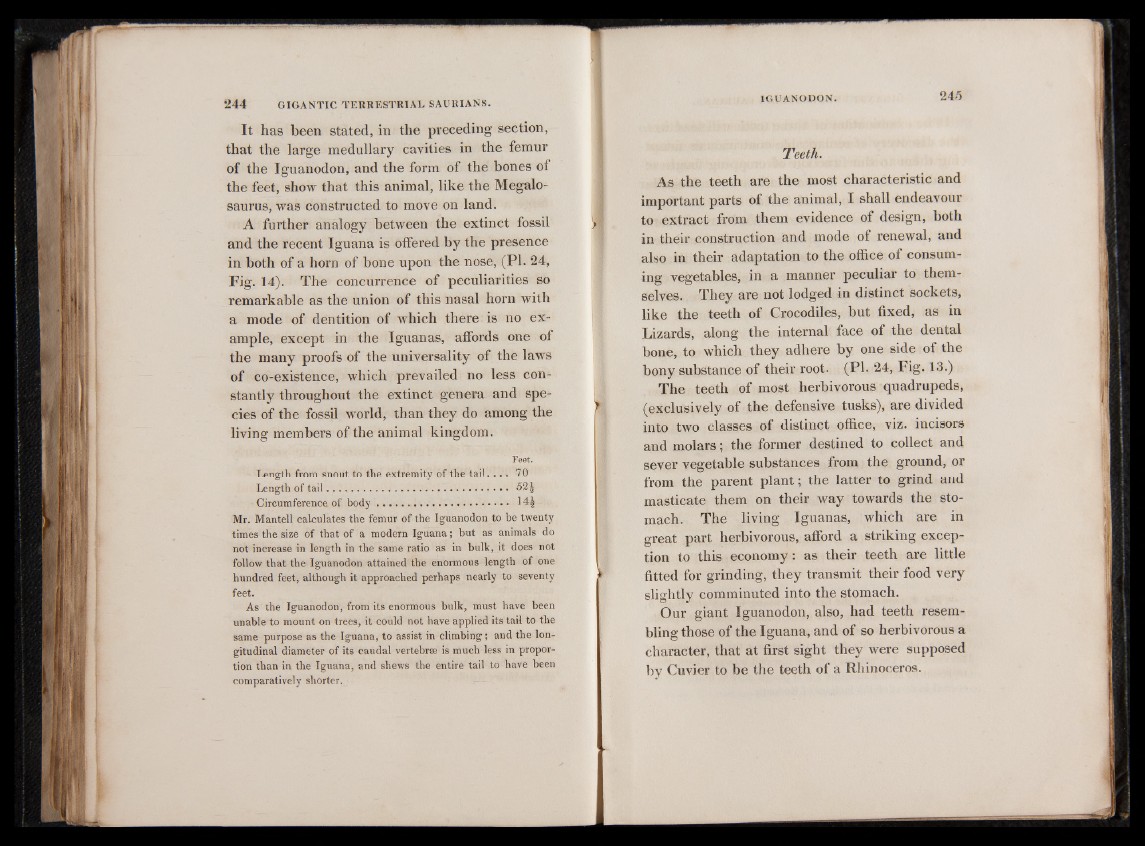
It has been stated, in the preceding section,
that the large medullary cavities in the femur
of the Iguanodon, and the form of the bones of
the feet, show that this animal, like the Megalo-
saurus, was constructed to move on land.
A further analogy between the extinct fossil
and the recent Iguana is offered by the presence
in both of a horn of bone upon the nose, (PI. 24,
Fig. 14). The concurrence of peculiarities so
remarkable as the union of this nasal horn with
a mode of dentition of which there is no example,
except in the Iguanas, affords one of
the many proofs of the universality of the laws
of co-existence, which prevailed no less constantly
throughout the extinct genera and species
of the fossil world, than they do among the
living members of the animal kingdom.
Feet.
Length from snout to the extremity of the tail. . . . 70
Length of ta il.................................................................... 52 J
Circumference of b o d y ................................................. 14^
Mr. Mantell calculates the femur of the Iguanodon to be twenty
times the size of that of a modern Iguana; but as animals do
not increase in length in the same ratio as in bulk, it does not
follow that the Iguanodon attained the enormous length of one
hundred feet, although it approached perhaps nearly to seventy
feet.A
s the Iguanodon, from its enormous bulk, must have been
unable to mount on trees, it could not have applied its tail to the
same purpose as the Iguana, to assist in climbing ; and the longitudinal
diameter of its caudal vertebrae is much less in proportion
than in the Iguana, and shews the entire tail to have been
comparatively shorter.
Teeth.
As the teeth are the most characteristic and
important parts of the animal, I shall endeavour
to extract from them evidence of design, both
in their construction and mode of renewal, and
also in their adaptation to the office of consuming
vegetables, in a manner peculiar to themselves.
They are not lodged in distinct sockets,
like the teeth of Crocodiles, but fixed, as in
Lizards, along the internal face of the dental
bone, to which they adhere by one side of the
bony substance of their root. (PI. 24, Fig. 13.)
The teeth of most herbivorous quadrupeds,
(exclusively of the defensive tusks), are divided
into two classes of distinct office, viz. incisors
and molars; the former destined to collect and
sever vegetable substances from the ground, or
from the parent plant; the latter to grind and
masticate them on their way towards the stomach.
The living Iguanas, which are in
great part herbivorous, afford a striking exception
to this economy: as their teeth are little
fitted for grinding, they transmit their food very
slightly comminuted into the stomach.
Our giant Iguanodon, also, had teeth resembling
those of the Iguana, and of so herbivorous a
character, that at first sight they were supposed
by Cuvier to be the teeth of a Rhinoceros.